
BRICS countries criticize U.S. tariffs at summit in Brazil
2025-07-07 00:00- The BRICS summit took place in Rio de Janeiro, Brazil, from July 5 to 6, 2025.
- Member countries discussed the impact of U.S. tariffs, Israel’s actions in Iran, and humanitarian crises in Gaza.
- The summit concluded with a formal expression of concern over U.S. tariffs, emphasizing the need for cooperation among emerging economies.
Express your sentiment!
Insights
Brazil hosted the 17th BRICS summit from July 5 to 6, 2025, where leaders from member countries discussed various significant issues. This year’s summit took place against the backdrop of the United States imposing new tariffs, which warranted a formal expression of concern from the group. Notably, due to the absence of influential leaders like China's President Xi Jinping, Brazil’s aim was to maintain a moderate agenda, avoiding provocation of U.S. President Donald Trump, who has previously exhibited hostility towards the organization. The Brazilian government indicated the summit would result in three joint statements and one final declaration, aiming for less contentious outcomes. Topics discussed included the humanitarian crises in Gaza and Iran, trade relations, and global health, albeit with a restrained approach to steer clear of drawing Trump’s ire.
Contexts
The report titled 'U.S. tariffs impact on BRICS countries' aims to analyze the effects of U.S. trade policies on the economies of BRICS nations, which include Brazil, Russia, India, China, and South Africa. Since the imposition of tariffs by the United States, these countries have seen various impacts on their trade balances, economic growth, and diplomatic relations. Understanding these consequences is vital for predicting future economic interactions and navigating the geopolitical landscape that has become increasingly complex due to the U.S. tariffs. The report highlights the specific sectors most affected and the relative resilience of each BRICS country's economy amid these challenges. Brazil, for instance, has faced a decline in soy exports to China, which was partially offset by increased domestic consumption and trade with other partners. Russia's energy sector has been more insulated from U.S. tariffs, benefiting from relatively high global oil prices. However, the sanctions related to tariffs have strained the economy in other sectors, leading to decreased investment. On the other hand, India's information technology and telecommunications sectors have experienced uncertainties, given their strong ties to the U.S. market and demand for skilled labor. China, however, presents a more complex scenario, where retaliatory tariffs have impacted its exports to the U.S., leading to a push for diversification of its trade partners and increased investment in domestic production. South Africa has seen its trade dynamics shift, with U.S. tariffs affecting its agricultural exports, particularly citrus fruits. However, the country has sought to leverage trade agreements with other nations to mitigate the impacts. The BRICS nations have also responded collectively to the challenges presented by U.S. tariffs, often calling for a more balanced and equitable global trade system. Enhanced cooperation among these countries, such as through initiatives in manufacturing and technology transfers, reflects a strategic pivot towards self-reliance and regional integration to counterbalance the economic pressures from U.S. trade measures. In conclusion, while U.S. tariffs have prompted immediate setbacks for BRICS countries, they have also sparked strategic adaptations and opportunities for diversification. Each nation’s response varies based on its economic structure and trade ties. The ongoing changes in global trade relations, prompted by these tariffs, are reshaping the economic landscape, necessitating a proactive approach from BRICS nations to bolster their resilience and re-evaluate their positions in international trade. The long-term effects of these tariffs on the BRICS economies will continue to unfold, influencing global trade patterns and alliances.